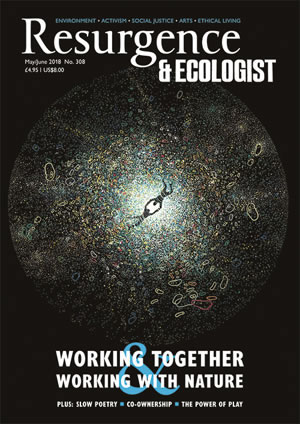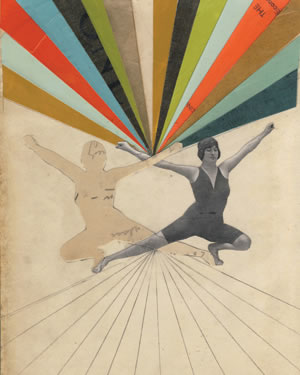Few would argue with the German philosopher Karl Groos, who suggested in his work The Play of Animals that we don’t stop playing because we grow old, but rather we grow old because we stop playing. Yet precious few adults pencil in ‘playtime’ on their to-do lists. It simply doesn’t chime with the modern, materialistic, time–stretched lifestyle; there is no money in play. And thus our playful spirit atrophies, and we age and wither accordingly.
My first epiphany about play as a counselling tool was in 1999, when I worked for a children’s charity in Lebanon. A boy shouted at me, using aggressive language reminiscent of an unruly adult, and his posture hinted at violence. I stood stock still, wondering what to do. Then I walked to the desk and got him a ballpoint pen and some paper. Of his own volition he drew spiral after spiral, pressing down on the paper with enormous tension. After a few minutes he stopped, and I took this as a cue to escort him out of the room to join his friends.
The interaction nevertheless had a faintly adult quality, of equals communicating. That perception stayed with me as I went on to train in child-centred education, as a Waldorf early years teacher. I later trained as a therapeutic play practitioner and then the more adult holistic counsellor, and I am currently training as a transpersonal arts counsellor.
Through my work experience I have developed a profound faith in the power of play for adults. This stems from a less dramatic epiphany when I was contemplating some clients, a friend and a colleague: a downbeat, resentful young man, a grieving woman, an anxious businessman, a young artist struggling with her confidence, and a middle-aged manager striving towards authentic leadership. What struck me was this: people carrying sadness and worry long-term never play. It’s as simple as that. Contrastingly, people living into a hopeful prognosis always had an element of play in their lives. Did it not follow that play in itself had the potential to move people from the miserable camp into the resilient camp?
Of course, therapists and counsellors have been cajoling their clients to play and enjoy life since time out of mind, but what about bringing play into the counselling room? I decided to do it, and have never looked back.
One of my clients, the US media personality Erika de la Cruz (who gave permission to use her name in this article), said: “The experience of using play to discover inner truths, subconscious insights and perspective felt more raw and real than a traditional [counselling] conversation for me. Rather than talking about the experience I was going through, I got to actually express it. It was so refreshing to revert back to childhood by playing with actual elements and toys.”
I see people gain an afterglow, a warmth and joie de vivre that transcend the quotidian. Daily life inevitably contains ongoing concerns that forever threaten to drag us down. Replenished by play, life becomes more manageable. I have often sensed that clients coming from work have a tense, neurotic disposition, a flat and sometimes enervating presence, while people who have had a playful day, even if they have expended a lot of physical energy, have a vibrant presence.
I have always played creatively: an evening habitué of the art classroom all through boarding school, followed by years in a dance troupe, performing as a puppeteer, and in improvised performance theatre. Initially, I wasn’t sure that play could be taken seriously in a counselling context, though I could see the potential of play meeting the needs of clients. I tried it anyway and, to put it romantically, I discovered the deep Keatsian beauty of play: it reveals truth. And sometimes it reveals truth that could have taken a month of Sundays to access through conventional counselling. This can occur with the darkest and most obscure troubles, when a client feels stuck after talking for unenlightening hours.
Let us be clear that we are dealing with full-on play here: child-like play (not simply childish play). We are not talking about the passive entertainment that absorbs hours each day as our hard-working bodies flop onto the sofa, stare at a screen and perhaps opt for a glass of vino escapo. Properly speaking, play requires a modicum of physical and mental effort. Nor is this the normal therapeutic role play where scenes from a client’s life are acted out or re-enacted. This is play where we pick roles that have no obvious bearing on our lives but suggest themselves as amusing or interesting – that is, playfully.
The spontaneity of play is key. An unravelling occurs, a sort of letting go whereby our minds are no longer consciously controlling what happens next. In these moments anything can happen. It chimes with Carl Jung’s observation, “Until you make the unconscious conscious, it will direct your life and you will call it fate.”
I have had clients suddenly understand the dynamics at work between themselves and their employer, client, child or partner, merely by playing out repressed feelings in supposedly unconnected stories and dramatic acting. While painting – again, in free-form style – the unconscious roams freely through a client’s life, and thus the client is often surprised at what ends up on the canvas, in clarifying symbolic language. It might be a picture of aching sadness between back-to-back figures, revealing that a relationship is over or that perhaps a hurt is deeper than previously realised.
Later reflection on what has been experienced during play can give new perspective and open clients up to the opportunity to make better-informed decisions. A drawing might evoke strong feelings and faith, even if it is simply faith in the mystery of life. Play always has that replenishing quality, even if nothing specific has been learnt.
Storytelling works, too: there is a realm of storytelling wherein we surprise ourselves with our own narrative twists and sympathetic characters. Enacting plays with figures in a sand tray can throw up realisations from very murky wonderings with regard to social dynamics. An arrangement of figures provides an overview, enabling us to observe from a place where we can gain space and perspective.
Playing in a group changes the dynamic, in that everyone is doing something together rather than just one talking while others listen or drift off awaiting their turn. Multifaceted interaction is constant when a group plays. People are enlivened, because they are constantly being stimulated by others.
These are just brief patterns I notice in play, but they all point to a distraction from hyper-consciousness, and a liberation of the spirit. It’s an easy process to observe and understand, even for those who have neglected play since childhood – sadly, most of us.
In play the unconscious is free to wander and explore, no longer under the strict cosh of the conscious, which is absorbed in the processes of the play-task. This can be extended to almost any form of creative play: mask making, for example, can throw up a lot of thoughts. Even simply playing with building blocks can call to mind the ephemeral or solid nature of relationships and troubles, good times and bad, as feelings of creativity and destruction course through our being.
Charlie Chaplin, a master of pathos, nailed it in one pithy line: “To truly laugh, you must be able to take your pain, and play with it!” I came across this saying when I discovered that my faith in the therapeutic value of play for perfectly sentient adults was not terribly original after all.
In fact, in the United States there is the highly esteemed National Institute for Play, founded by Stuart Brown, a leading psychiatric clinical researcher. He is a popular author, owing to his fascinating book Play: How It Shapes the Brain, Opens the Imagination, and Invigorates the Soul. From a counselling point of view, the words on the landing page of the Institute’s website sum up the appeal perfectly: “You can discover more about a person in an hour of play than in a year of conversation.”
However, we rarely talk about play so knowingly, as if it were a regularly available option – which it is. We simply don’t play much, and when we do it is usually within a specific time frame involving careful arrangements. It has been packaged into something small and pressurised. In an adult context the word ‘play’ most often means the intensity of formal, competitive sports booked in a sports facility. It’s fun, but it isn’t creative, open-ended play.
If I called myself a playfellow for hire, I would have no clients: it would sound unprofessional. Deep down I hope that is precisely what I am to many clients: a good playfellow. And I suspect we should all aspire to that tragically neglected role.







